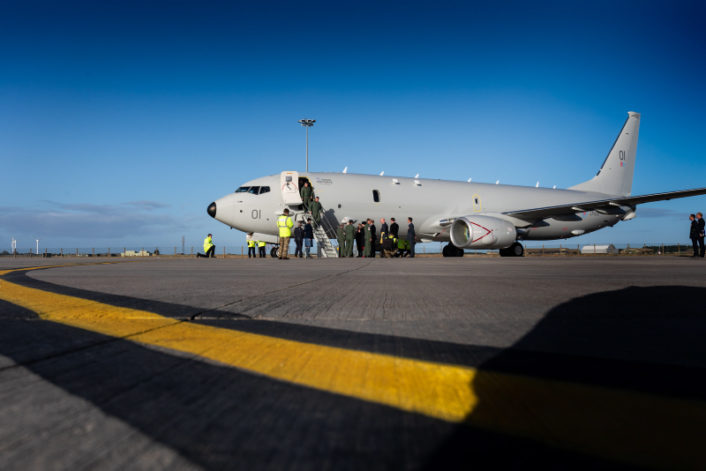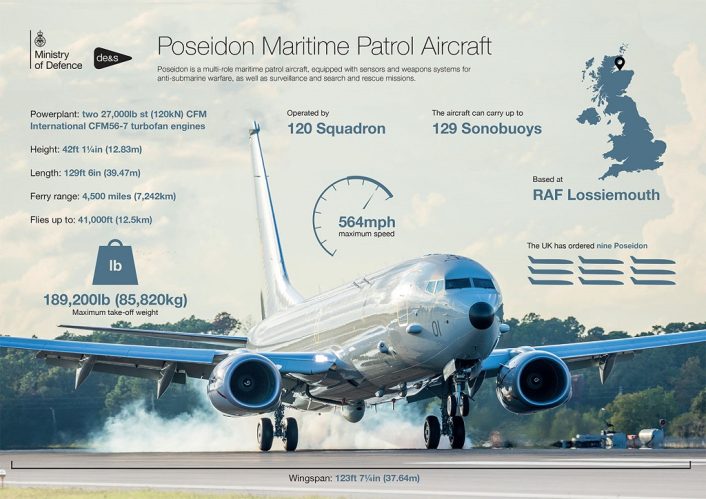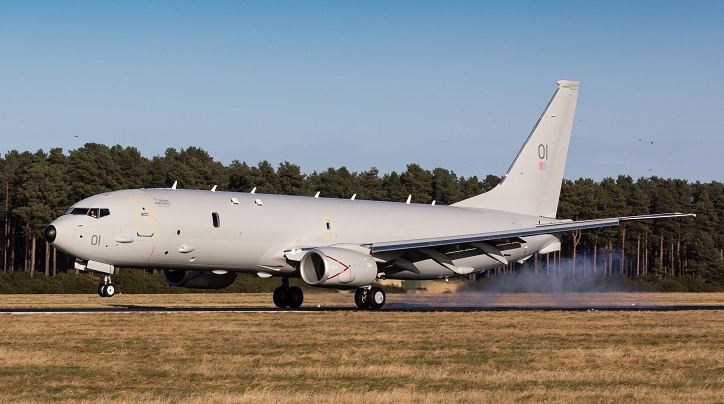The squadron will move to the final homebase at RAF Lossiemouth later this year.
Three months after the delivery of the first Poseidon MRA Mk.1 Maritime Patrol Aircraft at NAS Jacksonville, the 120 Squadron of the Royal Air Force returned to the U.K. on February 4, 2020. The “Pride of Moray”, as this aircraft was named after the heritage of Moray Firth and RAF Lossiemouth, landed at Kinloss Barracks, escorted by two Typhoons FGR4, in front of a crowd of authorities and the local population that gathered for the occasion.
After a long wait, it’s here!
Say hello to the Pride of Moray, our first of nine @P8A_PoseidonRAF! ZP801 landed at @Kinloss_Bks today, met by the @ChiefofAirStaff and Minister for the Armed Forces, @annietrev.#PoseidonArrival #SecuringTheSkies pic.twitter.com/FasS0AoK8I
— RAF Lossiemouth (@RAFLossiemouth) February 4, 2020
First aircraft is here @RAFLossiemouth @CXX_Squadron pic.twitter.com/hja26sWd3A
— Jamie Halls (@JamieHalls22) February 4, 2020
“The arrival of the first Poseidon marks a significant upgrade in the UK’s ability to conduct anti-submarine operations. This will give the UK the ability to conduct long range patrols and integrate seamlessly with our NATO allies to provide a world-leading capability. This will maintain operational freedom for our own submarines and apply pressure to those of our potential foes. I look forward to working with the RAF and our international partners on this superb aircraft”, said the First Sea Lord of the Royal Navy, Admiral Tony Radakin.

The squadron will stay at Kinloss Barracks until October 2020 while waiting for the completion of planned construction works at RAF Lossiemouth, the final homebase of the Poseidon fleet. Typhoons stationed at Lossiemouth will also relocate to Kinloss while the runways are resurfaced. The choice of Kinloss Barracks is particularly significant not only because of the proximity of the two airbases (less than 10 NM), but also because this is the former RAF Kinloss, where the Nimrod MR2 fleet was based before the retirement in 2010.
Following the Nimrod’s retirement, the airbase was closed and transferred to the British Army in 2012, becoming the home of the 39 Engineer Regiment.
“RAF Lossiemouth’s strategic northerly location makes it one of the most important air stations in the UK: already home to half of the UK’s Typhoon Force, and now sitting at the heart of our anti-submarine operations”, said Defence Minister Anne-Marie Trevelyan.
As @P8A_PoseidonRAF ZP801 arrived at Kinloss Barracks, ZP802 ‘City of Elgin’ was delivered to the RAF detachment @NASJax_ for acceptance. The aircraft will fly to Kinloss in about a month. #teamlossie @RAFLossiemouth. Amazing day. pic.twitter.com/7RR6KCjjuo
— CXX Squadron (@CXX_Squadron) February 5, 2020
The United Kingdom ordered nine Poseidons that will be delivered by the end of 2021, with Full Operational Capability expected at RAF Lossiemouth in 2024. The second Poseidon was delivered at NAS Jacksonville as the first one arrived at Kinloss. According to the official release, 120 Squadron will be joined in 2021 by 201 Squadron, which will be reactivated as second Poseidon squadron. Both squadrons previously operated the Nimrod MR2.

The Poseidon, a Boeing 737-800ERX derivative with reinforced 737-900 wings, is designed to carry out extended ISR (Intelligence, Surveillance and Reconnaissance) missions at high and low altitudes, from 41000 feet down to 200 feet above the water’s surface, with an operational range of 1200 nmi. The aircraft uses a wide range of sensors to perform its mission, as wrote in a previous article by our Editor David Cenciotti:
These assets are much more than MPA (Maritime Patrol Aircraft): they are multi-mission platforms that can gather valuable intelligence using a wide array of sensors. Among these, an Advanced Airborne Sensor (a dual-sided AESA radar that can offer 360-degree scanning on targets on land or coastal areas, and which has potential applications as a jamming or even cyberwarfare platform according to Northrop Grumman); an APY-10 multi-mode synthetic aperture radar; an MX-20 electro-optical/infrared turret for shorter-range search; and an ALQ-240 Electronic Support Measure (ESM) suite, able to geo-locate and track enemy radar emitters. Moreover, all sensors contribute to a single fused tactical situation display, which is then shared over both military standard and internet protocol data links, allowing for seamless delivery of information amongst U.S. and coalition forces.
In addition to its sensors, the Poseidon can use different combinations of sonobuoys for underwater search, with a total capacity of 129 sonobuoys, five MK 54 torpedoes or MK 82 depth charges in its weapons bay and up to four AGM-84 Harpoon anti-ship missiles on the external wing stations.
Just a few hours ago our first @P8A_PoseidonRAF, the Pride of Moray, departed from @NASJax_ on its first journey to the UK!
Track it on ADS-B receivers – search for ZP801 / RRR7078.
Further updates to come here. Stay tuned!#ItsComing pic.twitter.com/0doRVkDNRt
— RAF Lossiemouth (@RAFLossiemouth) February 4, 2020
As happened during the delivery flight to NAS Jacksonville, the arrival of the first Poseidon in the UK could be followed on ADS-B flight tracking websites by looking for the callsign RFR7078 and the serial ZP801. The event was also broadcasted live on the Royal Air Force’s social media.









